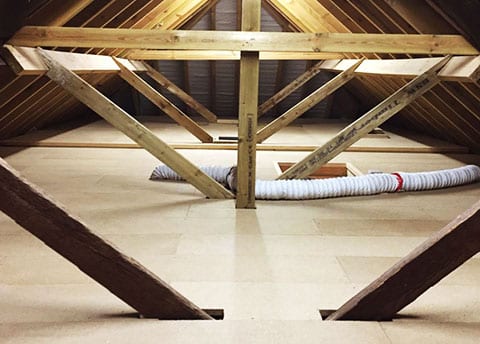The space at the top of the house has traditionally been used for storing things we want out of sight and out of mind — like Christmas decorations for the eleven months we don’t need them. In fact, whether you go for simple boarding or a full conversion, your loft can be a sophisticated storage area.
Here are a few things to bear in mind.
- Start by planning what you intend to be storing in your loft and how much access you’re likely to need. All your decisions should be based around this.
- There’s a choice between boarding out your loft or a full loft conversion (we don’t do those). A conversion enables you to use the loft as a room, whereas boarding over is normally enough if you just want storage space, and it doesn’t need planning permission.
- The insulation you need depends on what you’re planning to store. If any of the items are vulnerable to temperature swings and humidity, you’ll need insulation both between the joists and under the roof (“warm loft”).
- With “warm loft” insulation, you can store many items traditionally vulnerable to loft environments, such as clothing, books and photographs.
- Airflow throughout the loft is also an important factor these days. Most homes are now sealed in and any vapour which is created by simple daily activities will penetrate through the home and enter the loft. If there is insufficient airflow this vapour will condensate the moment it makes contact with a cold surface.
- If you have the recommended depth of insulation, you will need to raise the boards above the joists. The most efficient approach is to use the LoftZone StoreFloor system.
- Loft storage doesn’t have to be in boxes. Shelving or cupboards can be installed in the eaves area to save space and keep your possessions safer and more organised.
- It isn’t easy to keep track of what you store in the loft. If you really want to be able to access your possessions when you do need them, it helps to keep a record of what you’ve put up there, and where.
- The worst thing you can do is fill up your loft with so much stuff that you can’t reach anything. Plan where you’re going to put everything so you have room to move around.
- Make sure there’s plenty of light. Besides running electric lights up to the loft, you might consider installing roof windows, which don’t normally need planning permission.
- Be sure you have a good enough ladder, not only to get up and down yourself but also to make carrying boxes in and out of the loft easier.
If you’re still not sure what you’ll need for loft storage, feel free to get in touch with us for a chat.





